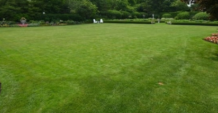Though there are high pH soils in most parts of the state, alkaline soils tend to be more common in the central and western regions of Kansas. These high pH soils can cause problems for plants by reducing the availability of certain micronutrients. For example, most Kansas soils have more than adequate amounts of iron. However, a high pH can make iron unavailable resulting in a condition known as iron chlorosis. Iron chlorosis reduces the health of plants by reducing photosynthesis. Lowering the pH of such soils will eliminate iron chlorosis.
Now would be a good time to have a soil test done to see if your pH is too high. If so, sulfur can be added either now or in the spring to lower the pH. Different textures of soil require different amounts. A sandy soil needs 7 pounds of sulfur per 1,000 square feet to reduce pH one point. A loam soil needs 11 pounds and clay needs 17 pounds to do the same. For example, if you wished to lower pH from 8.5 to 6.5 on a loam soil, you would need 22 pounds of sulfur per 1,000 square feet.
So, what pH do we shoot for? For most plants, a pH between 6.0 and 7.0 is preferred. Unfortunately, adding sulfur to lower pH is not as clear-cut a solution as we would like. Here are some other factors to keep in mind.
Free calcium carbonate: Some soils have free calcium carbonate, actual particles of limestone mixed in the soil. These “calcareous” soils normally have a pH of 7.3 to 8.5, with 8.2 to 8.3 being most common. In order for us to lower the pH with sulfur, all free calcium carbonate must be neutralized first. A recent soil test showed 6.7 percent free calcium carbonate. One pound of sulfur is needed to neutralize three pounds of calcium carbonate. Assuming 80 pounds for a cubic foot of soil, you would need about 1.75 pounds of sulfur per square foot just to neutralize the free lime. Additional sulfur would be needed to lower pH. Adding this much sulfur to a soil at one time is not recommended.
Not all high pH soils are calcareous. Perform this simple test to see if your soil contains appreciable amounts of free lime. Apply one drop of vinegar to dry soil. A vigorous fizz usually means the soil contains at least 3 percent calcium carbonate. A mild fizz suggests a calcium carbonate of between 1 and 2 percent and a fizz that can only be heard suggests the soil has a calcium carbonate content less than 1 percent.
How sulfur works: Elemental sulfur does not lower pH directly. It must first be oxidized to the sulfate form with the result being sulfuric acid. The sulfuric acid produces hydrogen, which
acidifies the soil and lowers pH. The oxidation takes place primarily through microbial activity.
Oxidation takes time: Microbial oxidation of elemental sulfur takes time and depends on:
– number of sulfur oxidizing bacteria present
– temperature (75-104 degrees optimum)
– moisture content of soil (too wet or too dry will slow down process)
– size of sulfur particles (the smaller the better)
A single sulfur application normally takes at least 2 years for most the sulfur to react and form sulfuric acid. This, of course, depends on the above factors. So, what do you do about calcareous soils? See the companion article in this week’s newsletter for specific recommendations. (Ward Upham)




